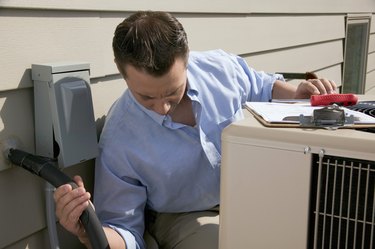
HVAC dampers control the amount of air that flows through a section of duct work. Manual volume dampers must be adjusted by hand; automatic control dampers are controlled automatically by the HVAC system. When a HVAC damper goes bad, proper airflow is no longer achieved through the duct work. You may end up with too little or too much airflow through the duct.
Step 1
Determine if your HVAC damper is a manual control damper or an automatic control damper. Manual dampers will have an adjustment handle on the side of the duct work; automatic dampers will have a control motor.
Video of the Day
Step 2
Follow the duct work from the damper to find out which registers it goes to. You will need to check the airflow out of these registers when the HVAC unit is running.
Step 3
Adjust the damper handle to the closed position if it is a manual control damper. Check the registers to see if the airflow has ceased. Adjust the damper to the open position and once again check the registers to see if the airflow has resumed. If you feel airflow when the damper is closed, or no airflow when the damper is open, the damper is most likely bad.
Step 4
Turn on the HVAC unit if you have an automatic control damper. Check the registers and feel for airflow. If you feel little airflow and the room is having problems maintaining temperature, or if you feel a lot of airflow and the room seems drafty, you probably have a faulty HVAC control damper.
Tip
Manual dampers can be replaced fairly easily if you have good home improvement skills. It involves a little disassembling of the duct work to replace all parts of the damper.
If you have an automatic damper that is bad, replacement is best left to a qualified HVAC technician because there can be extensive control wiring involved in the replacement process.
Video of the Day